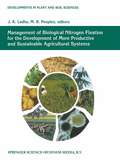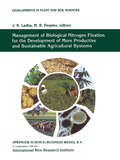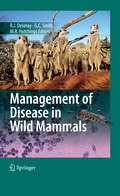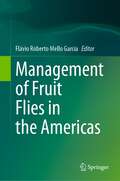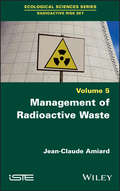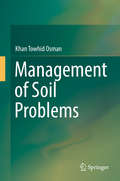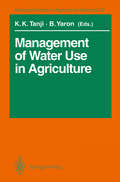- Table View
- List View
Management and Supervisory Practices for Environmental Professionals: Basic Principles, Volume I
by Herman Koren Alma Mary AndersonBased on the lifelong experiences of two authors as supervisors and teachers, the Fourth Edition of this bestseller provides up-to-date information for newly promoted or management-aspiring professionals and engineers in the fields of environmental health, occupational health and safety, water and wastewater treatment, public health, and many others. This first volume explains, through nine sets of tools, the basic principles supervisors need to understand the structure of their organization, what leadership is, how to effectively plan and budget, how to manage other people, and best practices for achieving success in a management position. In addition to those already practicing professionals in their fields, this book is an excellent resource for students interested in learning management skills prior to entering the workforce. Features of the Fourth Edition Helps to understand and utilize organizational structure to facilitate problem solving Offers a practical set of methods, tools, and techniques, all illustrated and easy to understand, for achieving leadership qualities Provides concise but essential discussion material for each topic, using the practical art of communications Includes thorough updates and many new case problems with answers provided Introduces self-testing questions for different situations and practical exercises utilizing an individual’s own work experience for answers
Management and Supervisory Practices for Environmental Professionals: Basic Principles, Volume I
by Herman Koren Alma Mary AndersonBased on the lifelong experiences of two authors as supervisors and teachers, the Fourth Edition of this bestseller provides up-to-date information for newly promoted or management-aspiring professionals and engineers in the fields of environmental health, occupational health and safety, water and wastewater treatment, public health, and many others. This first volume explains, through nine sets of tools, the basic principles supervisors need to understand the structure of their organization, what leadership is, how to effectively plan and budget, how to manage other people, and best practices for achieving success in a management position. In addition to those already practicing professionals in their fields, this book is an excellent resource for students interested in learning management skills prior to entering the workforce. Features of the Fourth Edition Helps to understand and utilize organizational structure to facilitate problem solving Offers a practical set of methods, tools, and techniques, all illustrated and easy to understand, for achieving leadership qualities Provides concise but essential discussion material for each topic, using the practical art of communications Includes thorough updates and many new case problems with answers provided Introduces self-testing questions for different situations and practical exercises utilizing an individual’s own work experience for answers
Management and Supervisory Practices for Environmental Professionals: Advanced Competencies, Volume II
by Herman Koren Alma Mary AndersonBased on the lifelong experiences of two authors as supervisors and teachers, the Fourth Edition of this bestseller provides up-to-date information for newly promoted or management-aspiring professionals and engineers in the fields of environmental health, occupational health and safety, water and wastewater treatment, public health, and many others. This second volume explains the advanced principles that supervisors need to understand the art of communications, resolving communications problems, and the supervisor/manager’s role in teaching, counseling, and managing employee performance and employee health and safety. In addition to those already practicing professionals in their fields, this book is an excellent resource for students interested in learning management skills prior to entering the workforce. Features of the Fourth Edition Helps to understand and utilize organizational structure to facilitate problem solving Offers a practical set of methods, tools, and techniques, all illustrated and easy to understand, for achieving leadership qualities Provides concise but essential discussion material for each topic, using the practical art of communications Includes thorough updates and many new case problems with answers provided Introduces self-testing questions for different situations and practical exercises utilizing an individual’s own work experience for answers
Management and Supervisory Practices for Environmental Professionals: Advanced Competencies, Volume II
by Herman Koren Alma Mary AndersonBased on the lifelong experiences of two authors as supervisors and teachers, the Fourth Edition of this bestseller provides up-to-date information for newly promoted or management-aspiring professionals and engineers in the fields of environmental health, occupational health and safety, water and wastewater treatment, public health, and many others. This second volume explains the advanced principles that supervisors need to understand the art of communications, resolving communications problems, and the supervisor/manager’s role in teaching, counseling, and managing employee performance and employee health and safety. In addition to those already practicing professionals in their fields, this book is an excellent resource for students interested in learning management skills prior to entering the workforce. Features of the Fourth Edition Helps to understand and utilize organizational structure to facilitate problem solving Offers a practical set of methods, tools, and techniques, all illustrated and easy to understand, for achieving leadership qualities Provides concise but essential discussion material for each topic, using the practical art of communications Includes thorough updates and many new case problems with answers provided Introduces self-testing questions for different situations and practical exercises utilizing an individual’s own work experience for answers
Management and Supervisory Practices for Environmental Professionals: Two Volume Set
by Herman Koren Alma Mary AndersonBased on the lifelong experiences of two authors as supervisors and teachers, the Fourth Edition of this bestseller provides up-to-date information for newly promoted or management-aspiring professionals and engineers in the fields of environmental health, occupational health and safety, water and wastewater treatment, public health, and many others. The first volume explains, through nine sets of tools, the basic principles supervisors need to understand the structure of their organization, what leadership is, how to effectively plan and budget, how to manage other people, and best practices for achieving success in a management position. The second volume explains the advanced principles that supervisors need to understand the art of communications, resolving communications problems, and the supervisor/manager’s role in teaching, counseling, and managing employee performance and employee health and safety. In addition to those already practicing professionals in their fields, this book is an excellent resource for students interested in learning management skills prior to entering the workforce. Features of the Fourth Edition Helps to understand and utilize organizational structure to facilitate problem solving Offers a practical set of methods, tools, and techniques, all illustrated and easy to understand, for achieving leadership qualities Provides concise but essential discussion material for each topic, using the practical art of communications Includes thorough updates and many new case problems with answers provided Introduces self-testing questions for different situations and practical exercises utilizing an individual’s own work experience for answers
Management Obligations for Health and Safety
by Gregory W. SmithIn recent years, the safety management field has placed leadership and commitment at the center of effective workplace health and safety programs. At the same time, personal liability for workplace health and safety has increased, resulting in poor outcomes for individual managers. Discussing the minimum expectations that courts and tribunals have
Management Obligations for Health and Safety
by Gregory W. SmithIn recent years, the safety management field has placed leadership and commitment at the center of effective workplace health and safety programs. At the same time, personal liability for workplace health and safety has increased, resulting in poor outcomes for individual managers. Discussing the minimum expectations that courts and tribunals have
Management Obligations for Health and Safety
by Gregory W. SmithIn recent years, the safety management field has placed leadership and commitment at the center of effective workplace health and safety programs. At the same time, personal liability for workplace health and safety has increased, resulting in poor outcomes for individual managers. Discussing the minimum expectations that courts and tribunals have
Management of Biological Nitrogen Fixation for the Development of More Productive and Sustainable Agricultural Systems: Extended versions of papers presented at the Symposium on Biological Nitrogen Fixation for Sustainable Agriculture at the 15th Congress of Soil, Acapulco, Mexico, 1994 (Boston Studies in the Philosophy and History of Science)
by J. K. Ladha, M. B. PeoplesTable 1. Global allocation of arable land between different com modities Globally, cereal cropping dominates cultivated land Commodities' Proportion of land area use (around 50% of total area, Table 1). The remain (%) ing arable land is used for production of oilseed, fibre, or food and cash crops. In addition, vast areas are Cereals maintained under temporary or permanent pasture for Wheat 16 forage production (2-3 fold greater than the total area Rice 10 under cultivation and permanent crop; Table 1, Fig. Maize 9 1). All cultivated crops, except for legumes (pulses All other cereals 13 and legume oil seeds) require the soil to provide rel Total 48 atively large amounts of nitrogen (N). It is necessary for the three most important cereals, wheat (Triticum Legumes aestivum), rice (Oryza sativa) and maize (Zea mays), Legume pulses 5 to take up 20 to 40 kg soil N ha -lover a period of 3 Legume oilseeds 6 to 5 months to satisfy the N requirements of the seed and supporting vegetative structure for each tonne of Total II grain produced (e. g. Fig. 2; Myers, 1988). Produc tive pastures on the other hand may assimilate> 100 Other crops I kg N ha- each annum, of which 50 to 90% will be Other oilseeds 6 consumed by livestock in intensively grazed systems Beverages / Tobacco 7 (Ledgardy, 1991; Thomas, 1995).
Management of Biological Nitrogen Fixation for the Development of More Productive and Sustainable Agricultural Systems: Extended versions of papers presented at the Symposium on Biological Nitrogen Fixation for Sustainable Agriculture at the 15th Congress of Soil Science, Acapulco, Mexico, 1994 (Developments in Plant and Soil Sciences #65)
by J. K. Ladha M. B. PeoplesTable 1. Global allocation of arable land between different com modities Globally, cereal cropping dominates cultivated land Commodities' Proportion of land area use (around 50% of total area, Table I). The remain (%) ing arable land is used for production of oilseed, fibre, or food and cash crops. In addition, vast areas are Cereals maintained under temporary or permanent pasture for Wheat 16 forage production (2-3 fold greater than the total area Rice 10 under cultivation and permanent crop; Table 1, Fig. Maize 9 O. All cultivated crops, except for legumes (pulses All other cereals 13 and legume oilseeds) require the soil to provide rel Total 48 atively large amounts of nitrogen (N). It is necessary for the three most important cereals, wheat (Triticum Legumes aestivum), rice (Oryza sativa) and maize (Zea mays), Legume pulses 5 1 to take up 20 to 40 kg soil N ha- over a period of 3 Legume oilseeds 6 to 5 months to satisfy the N requirements of the seed and supporting vegetative structure for each tonne of Total II grain produced (e. g. Fig. 2; Myers, 1988). Produc tive pastures on the other hand may assimilate> 100 Other crops kg N ha -\ each annum, of which 50 to 90% will be Other oilseeds 6 consumed by livestock in intensively grazed systems Beverages I Tobacco 7 (Ledgardy, 1991; Thomas, 1995).
Management of Climate Induced Drought and Water Scarcity in Egypt: Unconventional Solutions (SpringerBriefs in Environmental Science)
by Samiha A.H. Ouda Abd El-Hafeez ZohryThe book contains suggestion on suitable crop rotations for salt-affected soils to maximize the productivity of lands and water under current climate and under climate change in 2030. This book discusses droughts and water scarcity, which are important issues related to natural phenomena and affected by climate variability and change. It calls for reassessing the prevailing crop structure in Egypt under rain fed irrigation in North Egypt and under surface irrigation in the Nile Delta and Valley.Droughts affect rain fed agriculture, while water scarcity affects irrigated agriculture. The book investigates proposals for improving crop structure in these areas, taking into account the sustainability of water and soil resources. Further, it explores improved management options for crop production in both rain fed and irrigated agriculture. Lastly, it examines suggestions on more rational use of irrigation water in irrigated agriculture to conserve irrigation water under present climate conditions and to help meet the anticipated demand under climate change conditions.
Management of Disease in Wild Mammals
by Richard Delahay Graham C. Smith Michael R. HutchingsIn recent years nobody could have failed to notice the frequent and often sensati- alist media headlines warning of the latest global disease threat to humankind. But behind all the hyperbole lie real challenges related to dealing with the increasing incidence of emerging zoonotic disease events, the majority of which are thought to originate in wildlife (Jones et al. 2008). There are also many important diseases of domestic livestock which also occur in wildlife (e. g. foot and mouth disease and classical swine fever in wild boar, bovine tuberculosis in deer, badgers or possums), some of which can have a devastating impact on the farming industry, the wider rural economy and ultimately the public purse. But we should also not forget that wildlife diseases may have serious implications for the conservation of biodiversity. For some of the rarest, most endangered species (such as the Ethiopian wolf) d- ease may pose the greatest threat to their survival. If we are to avoid or reduce these impacts then we must improve our ability to detect and manage the risks associated with disease in wildlife populations. This is a challenge that will require expertise from many different disciplines: veterinary, ecological, medical, economic, poli- cal and zoological. In such an interdisciplinary field it is difficult to stay up to date with contemporary ideas and with techniques that may be rapidly evolving.
The Management of Forests (Routledge Library Editions: Forestry)
by F. C. OsmastonOriginally published in 1968, this book discusses the principles and methods on which forest management has been founded in the past and how these principles and methods still apply or are affected by modern management skills, changing demands, social habits and resources. The book is concerned mainly with the technical aspects of forestry and the classic foundations of management. To a lesser degree it deals with commercial efficiency, labour relations and the implications of these. The historical chapter shows the tends in the development of forestry, particularly in Europe.
The Management of Forests (Routledge Library Editions: Forestry)
by F. C. OsmastonOriginally published in 1968, this book discusses the principles and methods on which forest management has been founded in the past and how these principles and methods still apply or are affected by modern management skills, changing demands, social habits and resources. The book is concerned mainly with the technical aspects of forestry and the classic foundations of management. To a lesser degree it deals with commercial efficiency, labour relations and the implications of these. The historical chapter shows the tends in the development of forestry, particularly in Europe.
Management of Fruit Flies in the Americas
by Flávio Roberto Mello GarciaThis book comprises issues at the cutting edge of fruit fly management in the Americas, covering topics that are focal points of current activity and likely long-term importance to the progress of the field. The book is an invaluable source of ideas and inspiration for entomologists at all levels from graduate students to more-established researchers and professionals. Fruit flies (Diptera, Tephritidae) is the most important pests of fruit production worldwide. The purpose of this book is to integrate the experiences of leading scientists in the management of fruit flies in the Americas. In this work, species of fruit flies of economic importance are considered in the genera Anastrepha, Rhagoletis, Bactrocera, and Ceratitis. This book will address fruit flies monitoring, biological control, chemical control, cultural control, sterile insect technique (SIT), Integrated Pest Management (IPM), and other control methods. The book provides invaluable resource material to scientists, professionals and students.
Management of Irrigation and Water Supply Under Climatic Extremes: Empirical Analysis and Policy Lessons from India (Global Issues in Water Policy #25)
by M. Dinesh Kumar Yusuf Kabir Rushabh Hemani Nitin BassiThis volume provides a theoretical basis for the argument that available research that analyzes the impacts of climate on hydrology, water resources, and water systems, without factoring in the effect of climate variability, are inadequate and often misleading. Also, the book empirically shows that the impacts of climate variability on hydrology and water resources, and irrigation, water supply & sanitation systems are far more pronounced than the likely impacts of future change in climate. The book discusses technological, institutional and policy alternatives for reducing these impacts on various competitive use sectors, especially, irrigation, and water supply and sanitation through case studies of river basins in different hydrological setting.To set the context, the volume first presents the long term trends in precipitation and temperature in different regions of India, and compares them against inter-annual, inter-seasonal and intra-day variations in climatic parameters, to show how their differential impacts on water resources.
Management of Nitrogen and Phosphorus Fertilizers in Sub-Saharan Africa: Proceedings of a symposium, held in Lome, Togo, March 25–28, 1985 (Developments in Plant and Soil Sciences #24)
by Uzo M. Mokwunye Paul L. G. VlekFood security, one of the basic human rights, seems to be ever eluding the people of sub-Saharan Africa. With each occurrence of crop failure, agriculturalists around the world reawaken to the challenge of ensuring sta ble, adequate food production in the tropical African environments. The International Fertilizer Development Center (IFDC), with its mandate of alleviating food shortages through judicial use of fertilizers, formulated a program to study fertilizer use strategies for sub-Saharan Africa. With gener ous financial assistance from the International Fund for Agricultural Devel opment (IFAD), IFDC, in collaboration with the International Crop Re search Institute for the Semi-Arid Tropics (ICRISAT) and the International Institute for Tropical Agriculture (IIT A), initiated a research project aimed at assessing means to remedy soil nutrient deficiencies that constrain food production in the humid, subhumid, and semiarid tropics of Africa. The results of this project were summarized during a workshop held in Togo, March 25-28, 1985; the proceedings of that meetings are found in this vol ume. The project established collaboration with numerous national programs that were responsible for much of the data collection. The data presented in Chapters 6 and 9 include much of this information. We wish to acknowledge the contribution of the individual scientists, J.T. Ambe, F. Ganry, M. Gaoh, M. Issaka, J. Kiazolu, J. Kikafunde-Twine, K. Kpomblekou, F. Lompo, H.
Management of Radioactive Waste
by Jean-Claude AmiardThe classification of radioactive waste varies from state to state. This results in different management procedures for each country, while following IAEA and OECD/NEA recommendations.Radioactive waste comes from numerous sources. The largest volumes are generated by the decommissioning and dismantling of nuclear facilities. Long-lived, medium- and high-activity waste – categorized as the most hazardous types of waste – are in fact largely produced by nuclear power reactors, spent fuel reprocessing plants and nuclear accidents.Final disposal of very low-activity, low-activity and very short-lived waste is well controlled. However, final solutions for certain categories, including long-lived waste, sorted waste and spent graphite waste, are not yet in place.Management of Radioactive Waste reviews all the possible solutions and presents those chosen by the various states, including a chapter detailing policy on radioactive waste management, taking France as an example.
Management of Radioactive Waste
by Jean-Claude AmiardThe classification of radioactive waste varies from state to state. This results in different management procedures for each country, while following IAEA and OECD/NEA recommendations.Radioactive waste comes from numerous sources. The largest volumes are generated by the decommissioning and dismantling of nuclear facilities. Long-lived, medium- and high-activity waste – categorized as the most hazardous types of waste – are in fact largely produced by nuclear power reactors, spent fuel reprocessing plants and nuclear accidents.Final disposal of very low-activity, low-activity and very short-lived waste is well controlled. However, final solutions for certain categories, including long-lived waste, sorted waste and spent graphite waste, are not yet in place.Management of Radioactive Waste reviews all the possible solutions and presents those chosen by the various states, including a chapter detailing policy on radioactive waste management, taking France as an example.
Management of Recreation and Nature Based Tourism in European Forests
by Ulrike Pröbstl Veronika Wirth Birgit H. M. Elands Simon BellHere is, for the first time, a Europe-wide overview of the state of recreation and nature tourism in forests. It describes the current situation and conflicts in the different regions of Europe and provides solutions illustrated by good practice examples.
The Management of Schistosomiasis (Routledge Revivals)
by Patricia L. RosenfieldOne of the major considerations of any environmental resource project must be the effect on human well-being; originally published in 1979, this study aims to deal specifically with the transmission of Schistosomiasis as a human environmental impact. Due to its relationship with water, Schistosomiasis transmission areas can be spread or aggravated by new water resource projects particularly in developing countries, which could potentially lead to an epidemic situation. Rosenfield aims to demonstrate how prevention ideas can be conceived early on in the design process by exploring methodologies for predicting the prevalence of Schistosomiasis in certain areas and management strategies for controlling transmission. This title will be of interest to students of Environmental Studies and professionals.
The Management of Schistosomiasis (Routledge Revivals)
by Patricia L. RosenfieldOne of the major considerations of any environmental resource project must be the effect on human well-being; originally published in 1979, this study aims to deal specifically with the transmission of Schistosomiasis as a human environmental impact. Due to its relationship with water, Schistosomiasis transmission areas can be spread or aggravated by new water resource projects particularly in developing countries, which could potentially lead to an epidemic situation. Rosenfield aims to demonstrate how prevention ideas can be conceived early on in the design process by exploring methodologies for predicting the prevalence of Schistosomiasis in certain areas and management strategies for controlling transmission. This title will be of interest to students of Environmental Studies and professionals.
Management of Soil Problems
by Khan Towhid OsmanSoils are neither good nor bad, but some have inherent or acquired characteristics that may or may not suit our intended use. Unsuitable characteristics are considered to be soil problems, soil constraints or soil limitations. Only twelve percent of global land is right for agricultural production without much limitation. Some soils have severe limitations for crop production. These soils are so called ‘problem soils’. Many of them do not have enough fertility to be productive; some are arid and saline; some are very sandy and dry; and some are wet and waterlogged for most of the growing season. The global demand for food, wood, fuel, fiber, medicine and other plant products for the 7.2 billion current world population has created such an immense pressure on global soil resources that even the most fertile soils are losing their productive capacity. We are being compelled to bring more and more unsuitable or marginally suitable soils under cultivation. Unless innovative and integrated soil, crop and environmental management practices are adopted for their improvement and sustainable use, further degradation is inevitable. This book, Management of Soil Problems, identifies the problems and discusses management options in a smooth and reader-friendly style. It will be useful for students and professionals of soil science, agriculture, forestry, geography and environmental sciences.
Management of Transboundary Rivers and Lakes (Water Resources Development and Management)
by Olli Varis Cecilia Tortajada Asit K. BiswasTransboundary rivers and lakes are often the remaining new sources of water that can be developed for human uses. These water sources were not used in the past because of the many complexities involved. Written and edited by the world’s leading water and legal experts, this unique and authoritative book analyses the magnitudes of the transboundary water problems in different parts of the world. It also examines difficulties and constraints faced to resolve these problems.
Management of Water Use in Agriculture (Advanced Series in Agricultural Sciences #22)
by Kenneth K. Tanji Bruno YaronAs the world population increases, there is increasing competition for waterquantity as well as quality. Provided here is an up-to-date perspective on Available Water Resources (Part I), Water Conservation and Technology inAgricultural Systems (Part II), Problem Water Uses and Treatment (Part III),and Management and Policy Evaluation (Part IV). The book is an invaluable source of information for water resource planners, managers and policy makers, researchers and students, and irrigationists.




